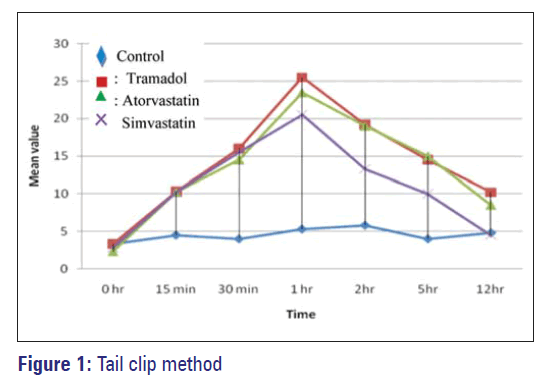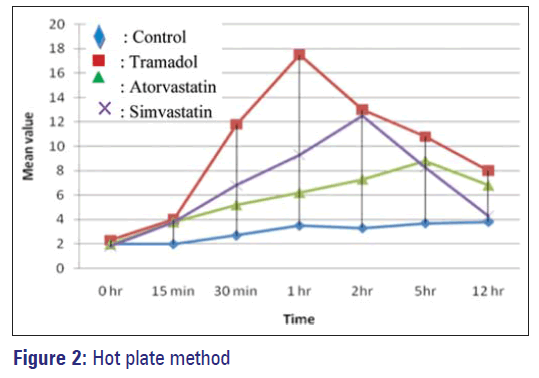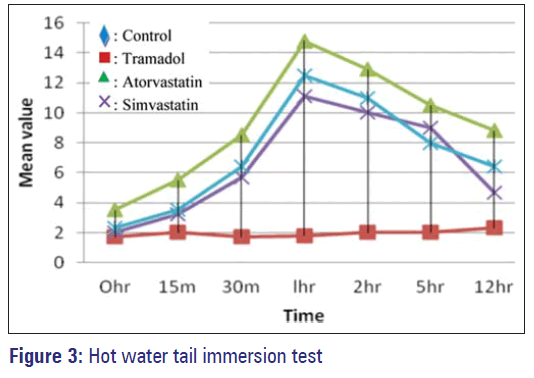Atorvastatin and simvastatin as analgesic agents in experimental models
- *Corresponding Author:
- Dr. Dwajani S
Division of Clinical Pharmacology, St.John's Medical College and Hospital, Bangalore-34, Karnataka, India.
E-mail: dwajani@gmail.com
Abstract
Objectives: 1) To evaluate the analgesic effect of atorvastatin and simvastatin. 2) To compare analgesic activity of these with an established drug tramadol. Materials and Methods: Healthy Albino rats were taken. They were randomly divided into 4 groups of six animals each. Group I: Normal Saline (0.5 ml), Group II: Tramadol (10 mg/kg BW), Group III: Atorvastatin (10 mg/kg BW) and Group IV: Simvastatin (10 mg/kg BW). The animals were subjected to 3 different tests at different interval of time. The tests conducted were tail clip method, Eddy’s hot plate and hot water tail immersion method. Results: Atorvastatin and simvastatin differ signifÂÂicantly from control hence they have analgesic action and even at any of the time intervals they do not differ signifÂÂicantly from tramadol; hence their analgesic effect is nearly comparable to tramadol. The results of the present study indicate that atorvastatin and simvastatin have analgesic action. Conclusion: These statins are found to have analgesic effect other than hypolipidemic activity and can be used in these patients. However further study has to be undertaken in a broader way.
Keywords
Analgesic, atorvastatin, rats, simvastatin
Introduction
Analgesics are the drugs that selectively relieve pain. The word analgesic derives from Greek an- (“without”) and algos (“pain”). These drugs act in various ways on the peripheral and central nervous systems. Analgesics are divided into 2 groups, Opiods and Non-Opiods. [1] In choosing analgesics, the severity and response to other medication determines the choice of agent. [2] Pain is defines as an unpleasant sensation and emotional experience associated with or without actual tissue damage [3] The analgesic choice is determined by type of pain. [4] There are different types of pain and the major ones include nociceptive pain, neuropathic pain. [5] We also have acute pain, chronic pain and cancer pain.
Statins are mainstay in the management of hyperlipidemias. These agents can reduce formation of the atherosclerotic plaques thereby reducing the morbidity and mortality of cardiovascular events [6] Statins come under the category of HMG Co-A reductase inhibitors, the rate limiting enzyme in cholesterol biosynthesis [7] Atorvastatin is reported to have analgesic properties and also potentiate the action of other analgesics. Barsante, Roffe, Yakora, have summarized that statins have prevented nociception which are observed in inflamed joints and can reserve as better analgesic. [8] Hence the present study is designed for exploring the analgesic potential of atorvastatin and simvastatin which may widen the therapeutic horizon for the said agents.
Objectives
1. To evaluate the analgesic effect of atorvastatin and simvastatin.
2. To compare the analgesic activity of these drugs with an established drug tramadol.
Materials and Methods
Animals required
Healthy, albino rats (150-250 gm) twelve weeks old of either sex, bred locally in the animal house of S.S. Institute of Medical Sciences and Research Center (SSIMSRC), Davanagere, are used for the study. They are housed under controlled condition of temperature 23 ± 2°C and 12 hour light and dark cycles respectively. The animals are housed individually in polypropylene cages containing sterile paddy husk, as bedding and are maintained on normal diet (Sri Durga feeds and foods, Bangalore) and water ad libitum. Animals are grouped into 4 of 6 animals each (n = 24).
Rationale for the use of animals
Since these are preliminary studies, the activity of above said drug has to be confirmed by animal experiments. As the rats are easy to handle, easily available, easy to subject them to testing and their nutrition resembles that of human. So, they are preferred for the usage for present study.
Study design
The animals were allocated randomly into 4 groups of 6 animals each as follows:
| Group | Received normal saline 0.5 ml i.p |
| Group II | Received tramadol 10 mg/kg BW |
| Group III | Received atorvastatin 10 mg/kg BW,[9] (Zydus Cadila) |
| Group IV | Received simvastatin 10 mg/kg BW,[10,11] (Micro Labs) |
The animals were subjected to following test at different time intervals i.e., 15 mins, 30 mins, 1hr, 2hr, 5hr, and 12hr after injection and the parameters were noted.
Tail clip test: In which a fine polythene sheathed artery forceps is applied to the tip of the tail and time taken for biting and effort to remove the same is noted, [12,13] Eddy’s hot plate method: The initial reaction time of all the animals of control and test groups were recorded by putting them on the hot plate maintained at 55.5°C. Licking of paw or jumping was taken as the index of reaction to heat. [14] Hot water tail immersion test: Water was heated to 55°C in a water bath. The time taken for the animal to remove it tail out of the water was recorded. [15]
Dosing schedule
All the drugs are given according to their body weight once before starting the test.
Statistical analysis
The results were subjected to ANOVA test and other suitable applications.
Results
Refer Tables 1-3 and Figures 1-3.
| Groups | Parameter | Time | ||||||
|---|---|---|---|---|---|---|---|---|
| 0 hr | 15 m | 30 m | l hr | 2 hr | 5 hr | 12 hr | ||
| Control | Mean | 3.3 | 4.5 | 4.0 | 5.3 | 5.8 | 4.0 | 4.8 |
| SD | 1.2 | 1.0 | 0.9 | 1.0 | 2.1 | 1.1 | 1.7 | |
| Tramadol | Mean | 3.3 | 10.3 | 16.0 | 25.5 | 19.2 | 14.5 | 10.2 |
| SD | 1.0 | 3.1 | 2.1 | 1.9 | 1.2 | 1.5 | 1.2 | |
| Atorvastatin | Mean | 2.3 | 10.2 | 14.5 | 23.5 | 19.0 | 15.0 | 8.5 |
| SD | 0.5 | 3.2 | 1.0 | 2.6 | 1.5 | 1.4 | 1.9 | |
| Simvastatin | Mean | 2.8 | 10.2 | 15.5 | 20.5 | 13.3 | 10.0 | 4.5 |
| SD | 0.8 | 2.9 | 2.6 | 3.0 | 1.5 | 2.8 | 1.9 | |
| P$Value, sig | 0.21 NS | <0.001 HS | <0.001 HS | <0.001 HS | <0.001 HS | <0.001 HS | <0. 001 HS | |
| Significant Pairs$$ | 1 and 2, 1 and | 1 and 2, 1 and | 1 and 2, 1 and | 1 and 2, 1 and | 1 and 2, 1 and | 1 and 2, 1 | ||
| 3, 1 and 4 | 3, 1 and 4 | 3, 1 and 4 | 3, 1 and 4 | 3, 1 and 4 | and 3 | |||
$ = Oneway ANOVA test, $$ = Tukey’s post hoc test
Table 1: Tail clip method: average reaction time in seconds
| Groups | Parameters | Time | |||||||
|---|---|---|---|---|---|---|---|---|---|
| 0 hr | 15 m | 30 m | l hr | 2 hr | 5 hr | 12 hr | |||
| Control | Mean | 2.0 | 2.0 | 2.7 | 3.5 | 3.3 | 3.7 | 3.8 | |
| SD | 0.6 | 0.6 | 0.5 | 0.8 | 0.8 | 0.5 | 1.7 | ||
| Tramadol | Mean | 2.3 | 4.0 | 11.8 | 17.5 | 13.0 | 10.8 | 8.0 | |
| SD | 0.5 | 0.6 | 0.8 | 1.9 | 1.4 | 0.8 | 0.9 | ||
| Atorvastatin | Mean | 2.0 | 3.8 | 5.2 | 6.2 | 7.3 | 8.8 | 6.8 | |
| SD | 0.6 | 1.3 | 1.0 | 1.6 | 1.4 | 1.3 | 0.8 | ||
| Simvastatin | Mean | 1.8 | 3.8 | 6.8 | 9.3 | 12.5 | 8.3 | 4.3 | |
| SD | 0.8 | 1.7 | 3.1 | 3.3 | 2.9 | 1.6 | 1.0 | ||
| P$Value, sig | 0.59 NS | 0.024 S | <0.001HS | <0.001 HS | <0.001 HS | <0.001 HS | <0.001 HS | ||
| Significant Pairs$$ | 1 and 2 | 1 and 2, 1 and 4 | 1 and 2, 1 and 4 | 1 and 2,1 and 3, | 1 and 2, 1 and 3, | 1 and 2, | |||
| 1 and 4 | 1 and 4 | 1 and 3 | |||||||
$ = Oneway ANOVA test, $$ = Tukey’s post hoc test
Table 2: Hot plate method: average reaction time in seconds
| Groups | Parameter | Time | ||||||
|---|---|---|---|---|---|---|---|---|
| 0 hr | 15 m | 30 m | l hr | 2 hr | 5 hr | 12 hr | ||
| Control | Mean | 1.7 | 2.0 | 1.7 | 1.8 | 2.0 | 2.0 | 2.3 |
| SD | 0.5 | 0.0 | 0.5 | 0.4 | 0.0 | 1.1 | 1.0 | |
| Tramadol | Mean | 3.5 | 5.5 | 8.5 | 14.8 | 12.9 | 10.5 | 8.8 |
| SD | 0.5 | 1.0 | 1.9 | 1.5 | 1.5 | 1.0 | 1.8 | |
| Atorvastatin | Mean | 2 | 3.2 | 5.7 | 11.1 | 10 | 9 | 4.7 |
| SD | 0.6 | 0.8 | 1.0 | 1.5 | 2.3 | 2.0 | 1.5 | |
| Simvastatin | Mean | 2.3 | 3.5 | 6.4 | 12.5 | 11 | 8 | 6.4 |
| SD | 0.5 | 1.0 | 1.9 | 1.5 | 1.5 | 1.0 | 1.8 | |
| P$Value, sig | 0.47 S | <0.001 HS | <0.001 HS | <0.001 HS | <0.001 HS | <0.001 HS | <0.001 HS | |
| Significant Pairs$$ | 1 and 2, | 1 and 2, | 1 and 2, | 1 and 2, | 1 and 2, | 1 and 2, | ||
| 1 and 3, | 1 and 3, | 1 and 3, | 1 and 3, | 1 and 3, | 1 and 3, | |||
| 1 and 4 | 1 and 4 | 1 and 4 | 1 and 4 | 1 and 4 | 1 and 4 |
$ = Oneway ANOVA test, $$ = Tukey’s post hoc test
Table 3: Hot water tail immersion test: average reaction time in seconds
Discussion
In the present study, the analgesic effect of atorvastatin and simvastatin was evaluated. And was compared with the analgesic activity of standard drug tramadol.
Tail clip method
Results From the Table 1 and Figure 1, it is evident that, at all the time intervals (i.e., 15 min, 30 min, l hr, 2 hr, 5 hr and 12 hr) atorvastatin and simvastatin differ significantly from control hence they have analgesic action and even at any of the time intervals they do not differ significantly from tramadol, hence their analgesic effect is nearly similar to tramadol.
Eddy’s hot plate method
Similar to tail clip test even in Table 2 and Figure 2, at all the time intervals (i.e., 15 min, 30 min, l hr, 2 hr, 5 hr and 12 hr) atorvastatin and simvastatin differ significantly from control hence they have analgesic action and even at any of the time intervals they do not differ significantly from tramadol, hence their analgesic effect is nearly similar to tramadol.
Hot water tail immersion test
Results from Table 3 and Figure 3 also indicate that the values of atorvastatin and simvastatin at all the time intervals (i.e.,15 min, 30 min, l hr, 2 hr, 5 hr and 12 hr) differ significantly from control hence they have analgesic action. And even at any of the time intervals they do not differ significantly from tramadol, hence their analgesic effect is nearly similar to tramadol.
Conclusion
In the present study analgesic effect of atorvastatin and simvastatin was evaluated using tail clip method, hot plate method and hot water tail immersion method in albino rats. Normal saline was used as a control and tramadol as a standard drug.
An increase in the reaction time is generally considered and important parameter of central and peripheral analgesic activity by non selective cox-inhibition and nociceptors. The results of the present study indicate that atorvastatin and simvastatin have analgesic action and it is nearly comparable to that of tramadol at all the time intervals. Further the effects start and attain the peak, very early: It therefore can be used in acute painful conditions. However further study has to be undertaken in a broader way to find the exact mechanism involved in the exerted action.
Acknowledgment
The required drugs were obtained from pharmaceutical companies, -Zydus Cadila and Micro Labs duly acknowledged.
References
- Available from: http://aspe.hhs.gov/health/reports/05/drugformularies/ch3.pdf. [last Accessed on 2009 Mar 20].
- Cancer pain relief and palliative care. Report of a WHO expert committee. World Health Organ Tech Rep Ser 1990;804:1-75.
- Available from: http://www.tensegrityphysicaltherapy.com/fi les/Understanding% 20Pain.pdf. [Last Accessed on 2009 Mar 20].
- Dworkin RH, Backonja M, Rowbotham MC, Allen RR, Argoff CR, Bennett GJ, et al. Advances in neuropathic pain: Diagnosis, mechanisms and treatment recommendations. Arch Neurol 2003;60:1524-34.
- Available from: http://www.action-on-pain.co.uk/documents/Types-of-Pain.pdf. [Last Accessed on 2009 Mar 20].
- Bonetti PO, Lerman LO, Napoli C, Lerman A. Statin effect beyond lipid loering, are they clinically revelant? Eur Heart J 2003;24:225-48.
- Holmberg E, Nordstrom T, Gross M, Kluge B, Zhang SX, Doolen S. Simvastatin promotes neurite outgrowth in the presence of inhibitory molecules found in central nervous system injury. J Neurotrauma 2006;23:1366-78.
- Barsante MM, Roffe E, Yakoro CM, Tafuri WL, Souza DG, Pinho V. Anti-infl ammatory and analgesic effect of atorvastatin in rat model of adjuvant induced arthritis. Eur J Pharmacol 2005;516:282-9.
- Yin Z, Fang Y, Ren L, Wang X, Zhang A, Lin J, et al. Atorvastatin accentuates NF-kappa B activation in trigeminal nucleus candalis in rat model of migrane. Neurosci Lett 2009;465:61-5.
- Ledingham JM, Lanerty R. Effect of simvastatin given alone and in combination with valsartan or enalapril on blood pressure and the structure of mesenteric resistance arteries and the basilar artery in the genetically hypertensive rat model. Clin Exp Pharmacol Physiol 2005;32:76-85.
- Simko F, Matuskova J, Luptak I, Krajcirovicova K, Kucharska J, Gvozdjakova A. Effect of simvastatin on remodeling of the left ventricle and aorta in L-NAME induced hypertension. Life Sci 2004;74:1211-24.
- Gantenbein M, Attolini L, Bruquerolle B. Kinetics of bupivacaine after nicorandil treatment in mice. J Pharm Pharmacol 1996;48:749-52.
- Lakkol Kiran J, Umakanth Patil N, Kallappa SG, Vinod Kumar CS. Assessment of local anesthetic activity of lignocaine by simultaneous administration of potassium channel agonists nicorandil in albino rats. IJABPT 2012;3:395-9.
- Srinivasa U, Venkateshwara Rao J, Krupanidhi AM, Shanmukappa S. Analgesic activity of justice beddomei leaf extract 2007;27:14-8.
- Indumathy S, Kavimani S. Analgesic activity of Angiotensin antagonists. Afr J Phar Pharmacol 2011;5:194-8.




